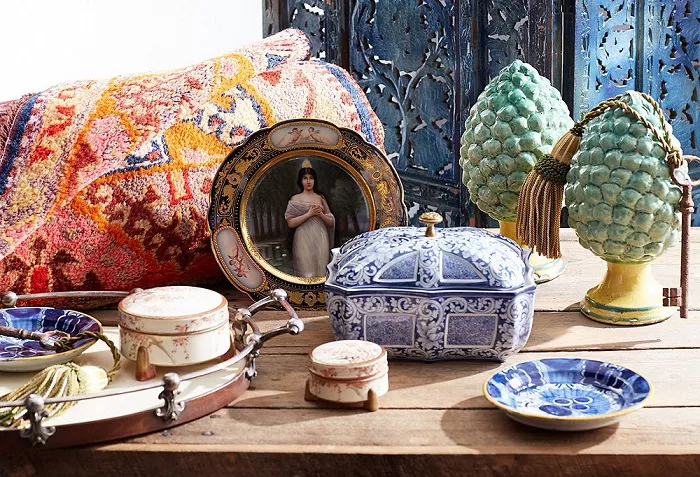Antiques once seen as symbols of status and long-term investment are now fetching a fraction of their original prices, as changing tastes, smaller homes, and global trade barriers reshape the market.
According to industry experts, many collectibles, heirlooms, and vintage furnishings that commanded high prices in the 1970s and 1980s have suffered dramatic declines in value. Pieces that once cost thousands are now worth only a few hundred pounds—or less—adjusted for inflation. For some categories, the decline is more than 90% in real terms.
Antique Furniture: From Investment to Afterthought
High-quality antique furniture made from mahogany, rosewood, oak, and walnut has seen some of the steepest declines. These once-prized items—such as dining tables, bookcases, and chests of drawers—are now often considered impractical in modern homes.
Douglas Carter, owner of Alice’s antique shop in London’s Portobello Road, links this trend to soaring property prices and shrinking living spaces. “You just can’t put a big mahogany dining table in a small flat,” he says.
Nadine Okker of Alfies Antique Market recalls that rosewood dining sets once fetched as much as £4,000 for the table and £1,500 for chairs. Adjusted for inflation, that equates to over £23,000 today. Currently, such sets may sell for only a few hundred pounds, reflecting a real-terms drop of over 98%.
Even smaller items like davenports and side tables, once valued at £700–£800, now sell for about £100. Bookcases that commanded £500 in the past can now be found for as little as £50 at auction.
“A friend of mine thought his furniture collection would fetch £80,000 at auction,” says Portobello dealer Judy Fox. “He got £6,000.”
Porcelain, Silverware, and Clocks Lose Their Shine
Porcelain dining sets, even from esteemed names like Royal Doulton, have lost much of their former appeal. Prices that once ranged between £100–£120 now struggle to reach £30.
Victorian silver-plated tea sets—once popularised by period dramas—have similarly collapsed in value. Former dealer Matteo Lombardi notes that items valued at several hundred pounds in the 1980s now sell for as little as £10–£50. Only solid silver sets retain value, buoyed by the rising price of raw silver.
Clocks, once cherished household staples, have also seen a downturn. Grandfather clocks that fetched £1,500 decades ago now rarely go for more than a few hundred pounds, due to shifts in both fashion and technology.
Decline Extends to Figurines, Glassware, and Writing Boxes
The minimalist trend has rendered many collectible items obsolete. Bisque figurines and Staffordshire dogs, once selling for hundreds, now struggle to attract buyers. A pair of Staffordshire dogs that sold for £200 in the 1980s (equivalent to £856 today) now fetch just £80–£90.
Vintage glassware has similarly fallen out of favour. Ornate Victorian wine glasses once valued at £25 now sell for as little as £5. Decorative centrepieces like epergnes, previously worth £500–£600, are now priced closer to £100—if there is interest at all.
Writing boxes, used in Victorian and Edwardian times for storing stationery, have also depreciated significantly. A high-quality box that fetched £300 in the 1980s would need to sell for £1,283 today to match inflation, but typically sells for the original nominal price, reflecting a 76.6% real-terms loss.
Teddy Bears and Standard Lamps No Longer Hold Value
The antique teddy bear market, which soared in the 1990s, has cooled considerably. Daniel Agnew, former head of Christie’s teddy bear auctions, notes that only the rarest bears—primarily those made between 1905 and 1920—have retained their value.
Standard lamps from the mid-20th century have also suffered. Once valued at £200 in the 1980s (£855 today), they now often fetch less than £100.
Bright Spots: Advertising Memorabilia and Vintage Watches
Not all antiques have fallen from grace. Advertising signs and taxidermy have seen notable appreciation. “The hottest antique right now is advertising paraphernalia,” says Carter. “A sign bought for £175 two decades ago could be worth over £2,000 today.”
Taxidermy, particularly fish mounts, has also risen sharply in value. Meanwhile, vintage watches remain a strong segment. A 1970s Omega Speedmaster, once priced at £250, can now exceed £5,000. High-end brands like Rolex continue to command premium prices, despite recent market softening.
The Broader Market Shift
Experts attribute the broader decline in antique values to changing lifestyles and aesthetics. “The main thing to remember about the antiques business is that it’s fashion,” says Carter. “People now want minimalist interiors, not ornate furniture.”
Compounding the issue are market constraints. The UK, once the world’s leading antiques exporter, has seen export volumes halve—from $1.3 billion in 2019 to $669 million in 2024—according to the UN Comtrade Database. Brexit-related trade frictions and U.S. tariffs have also curbed demand.
Judy Fox notes that “Europe doesn’t want what we sell, and Brexit makes it harder to export. Tariffs in the U.S. are another big hindrance.”
As domestic homes shrink—now 20% smaller than in 1970, according to consumer watchdog Which?—the market continues to favour compact, modular furniture from modern retailers over bulky heirlooms.
While experts advise that some rare or niche items still command strong prices, the broader antiques market reflects evolving consumer priorities—and a sharp reminder that not all sentimental items hold their value.

